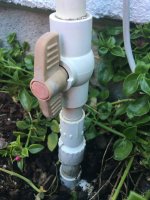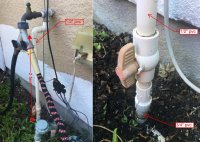Scott Fuller
New Member
I have a 4 zone irrigation system at my (small) home. 2 for the lawn, and 2 for planters/garden. One zone, for the front lawn (4 heads) is tapped off the main line before it enters the house. The other 3 are tapped off the rear yard just before the hose bib (rear yard is 6 heads). My main water line has a pressure reducer on it and the normal pressure is about 50psi.
All of the irrigation lines run through Lawn Genie anti-siphon valves. I'm trying to determine whether there are pressure reducers installed on the irrigation system since I can't see anything above ground that clearly indicates that they are.
Nothing is really wrong. I'm not getting any parts blowing out, but with some recent updates to my garden drippers, I get some overspray where drippers connect to 1/2" tubing (or the plugs in old holes won't seal the holes properly anymore) and sometimes it seems like the spray for the lawn is a bit to misty.
1. Is there any method for measuring pressure on the irrigation system itself? Some of it goes to spray heads, some goes to drip lines.
2. As far as I can tell, the anti-siphon valves don't act as pressure reducers (although they do have the valves to control flow a bit) Am I wrong? Do those serve as pressure reducers/regulators?
3. Do people normally install pressure reducers below grade? Maybe that's why I'm not seeing them?
4. Any chance any of these pieces (see photo) are a pressure reducer? I don't see any indication that they are, but I've also seen some photos of pvc reducers that look an awful lot like regular couplers.
Thanks for any help.
-Scott Fuller
All of the irrigation lines run through Lawn Genie anti-siphon valves. I'm trying to determine whether there are pressure reducers installed on the irrigation system since I can't see anything above ground that clearly indicates that they are.
Nothing is really wrong. I'm not getting any parts blowing out, but with some recent updates to my garden drippers, I get some overspray where drippers connect to 1/2" tubing (or the plugs in old holes won't seal the holes properly anymore) and sometimes it seems like the spray for the lawn is a bit to misty.
1. Is there any method for measuring pressure on the irrigation system itself? Some of it goes to spray heads, some goes to drip lines.
2. As far as I can tell, the anti-siphon valves don't act as pressure reducers (although they do have the valves to control flow a bit) Am I wrong? Do those serve as pressure reducers/regulators?
3. Do people normally install pressure reducers below grade? Maybe that's why I'm not seeing them?
4. Any chance any of these pieces (see photo) are a pressure reducer? I don't see any indication that they are, but I've also seen some photos of pvc reducers that look an awful lot like regular couplers.
Thanks for any help.
-Scott Fuller


